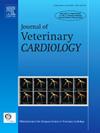狗颅腔静脉心动过速的高密度与逐点电解剖激活图谱。
IF 1.3
2区 农林科学
Q2 VETERINARY SCIENCES
引用次数: 0
摘要
一个七岁的男性完整的纽芬兰犬被转诊为室上性心动过速的导管消融。使用电解剖作图系统进行激活作图,以在解剖壳上以颜色编码的方式可视化激活波前。心房扑动在颅腔静脉出现早-晚信号(即疑似峡部)是最可疑的,但由于与膈神经重叠而无法定位。在随访中,一个更完整的高密度地图更好地勾勒出疑似颅内腔静脉颤振的电路和基底。与逐点导尿管相比,高密度导尿管增强了对低振幅电图信号的识别和注释。本文章由计算机程序翻译,如有差异,请以英文原文为准。
High-density versus point-by-point electroanatomical activation mapping of a cranial vena cava tachycardia in a dog
A seven-year-old, male intact Newfoundland was referred for catheter ablation of supraventricular tachycardia. Activation mapping was performed using an electroanatomical mapping system to visualize the activation wavefront in a color-coded fashion on an anatomical shell. Atrial flutter with an early-meets-late signal (i.e., suspected isthmus) at the cranial vena cava was most suspected, but could not be targeted due to overlap with the phrenic nerve. On follow-up, a more complete high-density map better outlined the suspected circuit and substrate of cranial vena cava flutter. Compared to point-by-point catheters, high-density mapping catheters enhance identification and annotation of low-amplitude electrogram signals.
求助全文
通过发布文献求助,成功后即可免费获取论文全文。
去求助
来源期刊

Journal of Veterinary Cardiology
VETERINARY SCIENCES-
CiteScore
2.50
自引率
25.00%
发文量
66
审稿时长
154 days
期刊介绍:
The mission of the Journal of Veterinary Cardiology is to publish peer-reviewed reports of the highest quality that promote greater understanding of cardiovascular disease, and enhance the health and well being of animals and humans. The Journal of Veterinary Cardiology publishes original contributions involving research and clinical practice that include prospective and retrospective studies, clinical trials, epidemiology, observational studies, and advances in applied and basic research.
The Journal invites submission of original manuscripts. Specific content areas of interest include heart failure, arrhythmias, congenital heart disease, cardiovascular medicine, surgery, hypertension, health outcomes research, diagnostic imaging, interventional techniques, genetics, molecular cardiology, and cardiovascular pathology, pharmacology, and toxicology.
 求助内容:
求助内容: 应助结果提醒方式:
应助结果提醒方式:


